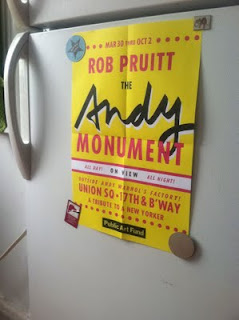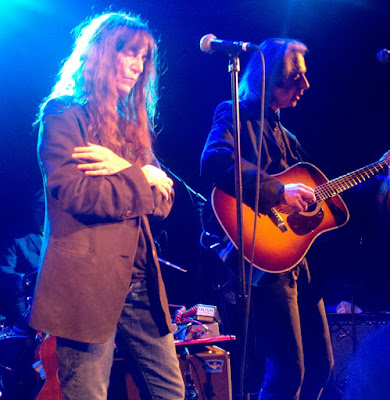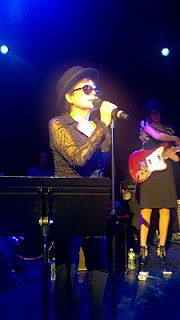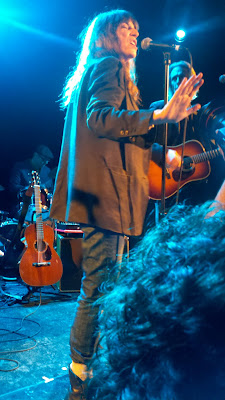 This concept manifest into a hard reality after I left the talk, as news came about a potential job having fallen through. Encouragements aside (and I do thank every one of you who’ve sent them), it was, and remains hugely, painfully disappointing. Simply put, I don’t know how I’m going to stay in the Big Apple without paid work. That’s a hard reality, and a scary one to confront. Talk about staring into the void.
This concept manifest into a hard reality after I left the talk, as news came about a potential job having fallen through. Encouragements aside (and I do thank every one of you who’ve sent them), it was, and remains hugely, painfully disappointing. Simply put, I don’t know how I’m going to stay in the Big Apple without paid work. That’s a hard reality, and a scary one to confront. Talk about staring into the void. Tag: New York Page 3 of 5
 This concept manifest into a hard reality after I left the talk, as news came about a potential job having fallen through. Encouragements aside (and I do thank every one of you who’ve sent them), it was, and remains hugely, painfully disappointing. Simply put, I don’t know how I’m going to stay in the Big Apple without paid work. That’s a hard reality, and a scary one to confront. Talk about staring into the void.
This concept manifest into a hard reality after I left the talk, as news came about a potential job having fallen through. Encouragements aside (and I do thank every one of you who’ve sent them), it was, and remains hugely, painfully disappointing. Simply put, I don’t know how I’m going to stay in the Big Apple without paid work. That’s a hard reality, and a scary one to confront. Talk about staring into the void.  Life has a way of turning out exactly like you didn’t plan. And yet it’s through the labyrinth of choice that we arrive at a new destination.
Life has a way of turning out exactly like you didn’t plan. And yet it’s through the labyrinth of choice that we arrive at a new destination.
Maybe part of my inspiration is derived from the bright yellow poster for The Andy Monument hanging on my fridge. When I look at it I remember first catching sight of Rob Pruitt‘s gorgeous monument to Andy Warhol in Union Square just steps from where The Factory was once located. It was a mild, breezy day, and the public space heaved with Saturday shoppers and curious tourists who would approach the silver-chrome statue slowly, eyebrows scrunched and head cocked, camera-phone on the ready. Some people knew who it was, some didn’t, but most people were in awe of its sheen, its shine, its winking, blinking surface that glinted and glowed in the late afternoon sunshine. Some posed beside the monument; others clicked away, but it wasn’t a manic picture-taking frenzy like you’d see beside other statues of famous people.
 There’s something curiously inspiring about this story. It got me thinking about the value we place on our activities, especially in the age of digital, where (especially as writers and artists) there is an expectation of “free” -a culture that has become a kind of monstrously growing pudding, one that keeps being fed by people who should know better. Whither worth? Everyone has to make a living -and has a right to. It can be, as Warhol serves to remind us, mundane, fantastical, or a mix of both (proudly), but we live in a culture where money is a vital form of energetic exchange. Those 15 minutes aren’t enough -you should either make money from it, or pay for it. Right? Wrong? It’s worth pondering, especially in an age where we choose to take and give things -talents, time, energy -without a thought. I wonder what Warhol would say.
There’s something curiously inspiring about this story. It got me thinking about the value we place on our activities, especially in the age of digital, where (especially as writers and artists) there is an expectation of “free” -a culture that has become a kind of monstrously growing pudding, one that keeps being fed by people who should know better. Whither worth? Everyone has to make a living -and has a right to. It can be, as Warhol serves to remind us, mundane, fantastical, or a mix of both (proudly), but we live in a culture where money is a vital form of energetic exchange. Those 15 minutes aren’t enough -you should either make money from it, or pay for it. Right? Wrong? It’s worth pondering, especially in an age where we choose to take and give things -talents, time, energy -without a thought. I wonder what Warhol would say.The rain started in light spurts when I got off the subway Tuesday night. Fast-gathering clouds leaned down on an glassy towers and old concrete masses alike with bullying persistence. People glanced up nervously at the sky as they scurried along the sidewalks like nervous beetles. I’d just turned on Peter Gabriel’s beautiful cover of Elbow’s “Mirrorball” on my iPod and was wondering if anyone could hear the magnificent genius that was ringing, bell-like, in my ears. The track is taken from his gorgeously poetic album of covers, Scratch My Back, released in February through Virgin Music. The album contains a myriad of thoughtful, sometimes surprising cover versions, including Lou Reed’s sigh-worthy “The Power Of The Heart” (his proposal to now-wife Laurie Anderson), Paul Simon’s “Boy In The Bubble”, as well as David Bowie’s much-loved “Heroes”. The album is fast becoming a favorite on my iPod. It’s a million miles away from the noisy, posturing, abrasive world of modern pop. It’s not exactly get-up-and-boogie music, but rather, sit-down-and-shut-up music -and I like that. I wish more of that genre existed.
 Far from being the bleeping, bloopy, busy electro-pop sound Gabriel became known for in the 1980s, Scratch My Back features minimalist production, a quality that immediately caught my attention. It’s very dramatic for its lack of instrumentation, and its careful consideration of orchestration in the way of what to put, and where. “Mirrorball” is a stand-out for its phenomenal string arrangements from Guy Garvey that, to quote Gabriel himself, “use all the colours of the orchestra to provide the heart, passion, intensity and groove” that lay dormant, if vibrantly alive, within the Elbow original. It does sound like Stravinsky -and Eno, and opera, prayer, incantation, invocation, moan and shudder, all at once. Upon first listen, walking through the ever-dampening, rapidly-darkening street in a New York borough, I wanted to weep, laugh, run, and stand still, all at once. Gabriel’s knowing, intimate delivery offers a beautiful, world-weary understanding of life and its variance. This begs for a video made in New York, complete with the huge, white flash of light and earth-shaking eruption of thunder that greeted its end the evening I listened to it.
Far from being the bleeping, bloopy, busy electro-pop sound Gabriel became known for in the 1980s, Scratch My Back features minimalist production, a quality that immediately caught my attention. It’s very dramatic for its lack of instrumentation, and its careful consideration of orchestration in the way of what to put, and where. “Mirrorball” is a stand-out for its phenomenal string arrangements from Guy Garvey that, to quote Gabriel himself, “use all the colours of the orchestra to provide the heart, passion, intensity and groove” that lay dormant, if vibrantly alive, within the Elbow original. It does sound like Stravinsky -and Eno, and opera, prayer, incantation, invocation, moan and shudder, all at once. Upon first listen, walking through the ever-dampening, rapidly-darkening street in a New York borough, I wanted to weep, laugh, run, and stand still, all at once. Gabriel’s knowing, intimate delivery offers a beautiful, world-weary understanding of life and its variance. This begs for a video made in New York, complete with the huge, white flash of light and earth-shaking eruption of thunder that greeted its end the evening I listened to it. It was beautiful in New York today.
It was beautiful in New York today.
The sun was shining, the sky was a lustrous blue, it was mild. The rain that had been threatened all weekend didn’t materialize. People were happy to welcome the spring weather, walking around in loose t-shirts and perhaps-too-soon rubber sandals. I got off work and decided I’d make a trip back to Strand Books. Poetry was calling, along with a general desire to walk around Manhattan on a gorgeous Monday afternoon and observe, reflect, walk, and breathe. The rhythm of street life -of peddlers, poets, con artists, lovers, dreamers, stragglers, strugglers, tired parents, scared tourists, oblivious locals, obnoxious students – all co-mingle here with a natural harmony that is both breathtaking and choking. Get out of the way!, I wanted to shout every few steps, if you want to yap with your boyfriend, don’t try to walk at the same time! Surely it’s a sign of becoming a local, though I still get shocked looks whenever I say “thank you” in a store. Habits from home die hard.
 Trying to write about a litany of amazing experiences is like trying to file spaghetti bolognese by ingredient -after it’s cooked and on your plate.
Trying to write about a litany of amazing experiences is like trying to file spaghetti bolognese by ingredient -after it’s cooked and on your plate.
Friday night I attended Monodramas at the New York City Opera. Then I had a great meal, met some great people, and walked through a curiously-quiet Times Square. Saturday I went to the legendary Strand Books, and later explored the Lower East Side with a local friend. Today I heard another friend sing at a favorite spot on the Upper West Side, and on the way there, chatted about the wonders of Bukowski with a fellow commuter.
Together these things seem unremarkable, but… trying to put them into some kind of order, and sense, parsing out their colors, textures, sounds, meanings, the small spaces of light between the blocks of firm monolithical EVENTS… is hard. Such efforts demand a certain commitment of time and energy and availability of mind and spirit and fingers, to sit, think, contemplate, and type. Time isn’t always on my side.
New York is swallowing me up, and I’m enjoying being in the throes of its guts, thrown this way and that, against hardship, wellship, friendship and relationship. I want to sit down and try to make sense of all this, slowly, carefully, and against the grain of everything New York demands. I love the fast rhythm, but I like the slow numbers too, and I have to mind the splinters and dirt while I’m at it. Never mind the glam, here’s bare feet, dry hands, red eyes and low voice. Add a glass of red, Sinatra on the stereo, and a room with a view -or at least access to a great, busy street – and I’ll truly feel I have arrived. Until then, I’m on input mode.
 It was surreal to attend a movie about Dave Grohl’s band that was built on the ashes of Nirvana on the very day that marked 17 years since Kurt Cobain’s passing.
It was surreal to attend a movie about Dave Grohl’s band that was built on the ashes of Nirvana on the very day that marked 17 years since Kurt Cobain’s passing.
Meat-eating orchids forgive no one just yetCut myself on angel hair and baby’s breath
Broken hymen of Your Highness – I’m left black
Throw down your umbilical noose so I can climb right back
 At this time last week, I was on a bus racing towards the Canadian/American border, luggage in tow and pie-eyed with worry, anxiety, sadness, and excitement. It was a strange feeling, to zoom by all the familiar sights -first the CN Tower (bathed in red in honour of the city’s various charity efforts for Japan), then the low-slung buildings and depressing box malls of the suburbs, and finally the vast vineyards of Niagara. I wasn’t sentimental so much as impatient, though I kept telling myself it was a long journey ahead – both literally, on the damn bumpy bus, and figuratively, in the oh-my-gawd-what-am-I-doing? sense.
At this time last week, I was on a bus racing towards the Canadian/American border, luggage in tow and pie-eyed with worry, anxiety, sadness, and excitement. It was a strange feeling, to zoom by all the familiar sights -first the CN Tower (bathed in red in honour of the city’s various charity efforts for Japan), then the low-slung buildings and depressing box malls of the suburbs, and finally the vast vineyards of Niagara. I wasn’t sentimental so much as impatient, though I kept telling myself it was a long journey ahead – both literally, on the damn bumpy bus, and figuratively, in the oh-my-gawd-what-am-I-doing? sense.
 To Japan With Love was announced a week before my departure. It featured Cibo Matto, Antony (Hegarty), Patti Smith, and Yoko Ono and the Plastic Ono band, which included son Sean Lennon. I knew precious little about Yoko, but she’s always been a woman for whom I have a deep and abiding respect. It can’t be easy to live with the musty old you-broke-up-The-Beatles moniker for decades, much less the ‘Shrieking Weirdo Artist‘ one (tho I suspect she’d like that). I made sure to leave early and line up outside the Bleecker Street club for a prime spot, and soon began chatting with enthusiastic New Yorkers who not only knew Yoko’s work well, but who were big fans and admirers. One Japanese fan even identified a club across the street – Kenny’s Castaways – as being a spot where she’d played an important gig in 1974. Everything -and everyone -has a story, especially here in New York.
To Japan With Love was announced a week before my departure. It featured Cibo Matto, Antony (Hegarty), Patti Smith, and Yoko Ono and the Plastic Ono band, which included son Sean Lennon. I knew precious little about Yoko, but she’s always been a woman for whom I have a deep and abiding respect. It can’t be easy to live with the musty old you-broke-up-The-Beatles moniker for decades, much less the ‘Shrieking Weirdo Artist‘ one (tho I suspect she’d like that). I made sure to leave early and line up outside the Bleecker Street club for a prime spot, and soon began chatting with enthusiastic New Yorkers who not only knew Yoko’s work well, but who were big fans and admirers. One Japanese fan even identified a club across the street – Kenny’s Castaways – as being a spot where she’d played an important gig in 1974. Everything -and everyone -has a story, especially here in New York. Still, the coughing took a definite backseat when Patti came on. With her long, grey-streaked hair, bright eyes, broad smile, thick socks and big army boots, she looked utterly glamorous, strong, defiant, and beautiful. Her voice was like caramel: rich, deep, solid, the sort you want to swim in through a cold, rainy evening. She and her band (which included original members Lenny Kaye and Jay Dee Daugherty, along with Tony Shanahan, as well as her daughter on piano and son on guitar) held the room’s rapt attention as they launched into slower hits, as Patti gently, elegantly reminded the audience about the purpose of the evening. She showed her annoyance with that obnoxious photographer in front of me, as her eyes flashed with anger after he kept madly snapping past the fourth song. During an angry, passionate, spit-inducing performance of “Pissing In A River” (one of my all-time favorites), Patti folded her hands, bowed her grand head, and went… somewhere else. Somewhere very deep within herself physically, occupying a private space within a public context, showing herself to be both deeply theatrical and deeply veneered, all at once. Captivating.
Still, the coughing took a definite backseat when Patti came on. With her long, grey-streaked hair, bright eyes, broad smile, thick socks and big army boots, she looked utterly glamorous, strong, defiant, and beautiful. Her voice was like caramel: rich, deep, solid, the sort you want to swim in through a cold, rainy evening. She and her band (which included original members Lenny Kaye and Jay Dee Daugherty, along with Tony Shanahan, as well as her daughter on piano and son on guitar) held the room’s rapt attention as they launched into slower hits, as Patti gently, elegantly reminded the audience about the purpose of the evening. She showed her annoyance with that obnoxious photographer in front of me, as her eyes flashed with anger after he kept madly snapping past the fourth song. During an angry, passionate, spit-inducing performance of “Pissing In A River” (one of my all-time favorites), Patti folded her hands, bowed her grand head, and went… somewhere else. Somewhere very deep within herself physically, occupying a private space within a public context, showing herself to be both deeply theatrical and deeply veneered, all at once. Captivating.All photos by Jon Rosenbaum.
My first night in New York was spent at (le poisson rouge), a fantastic live arts space in the Village. As soon as I heard the lineup announced last week for a special Japan benefit show, I knew I had to be there. It was my long-awaited chance to see Patti Smith.



